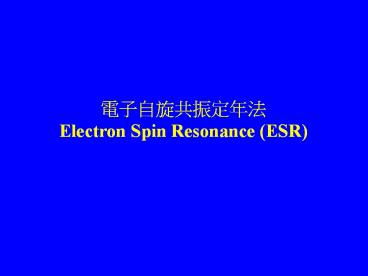Electron Spin Resonance (ESR) - PowerPoint PPT Presentation
Title:
Electron Spin Resonance (ESR)
Description:
The g-value is characteristics of a simple paramagnetic center in a crystal lattice. ... room temperature is caused only by 0.16% of all paramagnetic electrons. ... – PowerPoint PPT presentation
Number of Views:2200
Avg rating:3.0/5.0
Title: Electron Spin Resonance (ESR)
1
????????? Electron Spin Resonance (ESR)
2
(No Transcript)
3
(No Transcript)
4
(No Transcript)
5
(No Transcript)
6
????
???????????????????
ms Magnetic moment mB Bohr magneton 9.27314
x 10-21 erg Gauss-1 g Lande factor(used as
g-value) h' Planck's constant(6.62554 x
10-27erg sec-1)/2p S Spin quantum number (for a
pure spin-magnetism, g-value2.002319)
7
(No Transcript)
8
(No Transcript)
9
The g-value is characteristics of a simple
paramagnetic center in a crystal lattice. For a
pure isolated spin of a free electron the
g-value2.002319.
10
If unpaired (s 1/2) electrons are submitted to
an external static magnetic induction field H (in
the z-direction), there are only two discrete
possible orientations of the electron spin Sz
with regard to the magnetic field Sz
1/2h' The magnitude of the magnetic moment in
z-direction mz (gmB/h')(1/2h') 1/2gmB
11
The interaction of this magnetic moment (mz) of
the electron with the external magnetic field H
results in a splitting of the initial energy
level (E0) into two discrete energy levels E and
E- (Zeeman energies) E E0 mzH and E- E0 -
mzH, so that E E0 1/2 gmBH and E- E0 - 1/2
gmBH ?E gmBH
12
By addition of external energy (e.g. in the
form of microwave radition) it is possible to
transfer electrons from the lower Zeeman level to
the higher level. Electromagnetic radiation can
only exchange energy in the form of discrete
quanta hn (n radiation frequency).
Consequently the following resonance condition
for the transfer of electrons must be met hn
gmBH h Planck's constant(6.62554 x 10-27erg
sec-1) n microwave frequency (sec-1Hz) H
magnetic field strength (Gauss)
13
The number of electrons (population) N and N-
in the two levels are given by the Boltzmann
distribution k Boltzmann constant 1.385 x
10-16 T Temperature(K) n in units of (109
sec-1) GHz
14
(No Transcript)
15
(No Transcript)
16
(No Transcript)
17
Insertion of ? 10 GHz and T room temperature
in the above equation yields an excess of only
0.16 electrons on the lower Zeeman level (E-),
so the ESR signal at room temperature is caused
only by 0.16 of all paramagnetic electrons.
Usually the population of trapped electrons of E-
is higher than E and consequently the absorption
of microwave power dominates. This system,
however, tends to equalize the population of both
levels, that then will be neither absorption nor
emission.
18
(No Transcript)
19
(No Transcript)
20
(No Transcript)
21
(No Transcript)
22
(No Transcript)
23
(No Transcript)
24
(No Transcript)
25
(No Transcript)
26
(No Transcript)
27
(No Transcript)
28
(No Transcript)
29
(No Transcript)
30
(No Transcript)















![A Thumb rule to work out Electron Spin Resonance Frequency [and the corresponding Proton NMR frequency] is as follows: PowerPoint PPT Presentation](https://s3.amazonaws.com/images.powershow.com/A1257278165YQMfv.th0.jpg?_=202011170811)














